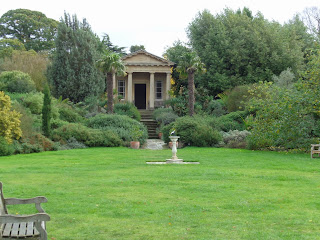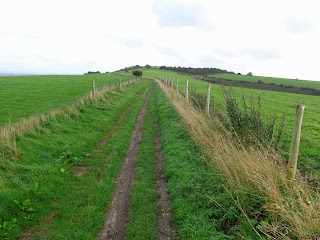 |
Lots of scrumptious architecture in town, such as these almshouses (built by charitable bequests to house poor parishioners) from the 1840s.
Lots of cute boutiques and delectable restaurants all over the place - a very high-end shopping district . . .
including, of course, a brand-new Whole Foods. Think Dupont Circle or Georgetown - with real estate prices to match (condo studios appear to start at about $400,000).
Most of my time was spent at the National Archives in neighboring Kew (the reading room is on the second floor in the bunker-like wing on the left). But that place was very well-organized, so I managed to get my research done more quickly than anticipated, leaving me some time to go exploring.
One place I visited was Richmond Park, a 3.5-square mile area of open grassland and woodland just south of the town of Richmond first used as a deer park by the Tudor kings. Heavenly in its peacefulness - except that it lies directly under the final approach for Heathrow Airport.
A large herd of deer were grazing in a broad meadow in the middle of the park, giving the impression of a British Serengeti.
The lake at the park featured a couple of white swans - actually quite common here (I haven't yet seen any in ponds around Washington).
Another bird found quite frequently here is the coot (so when you call me an old coot, this is what you are picturing me to look like). This is the European species; I have encountered the American species (with a slightly smaller white face shield) on the Mall in Washington.
I also went to Kew Gardens, which are the Royal Botanical Gardens - a vast and beautifully landscaped arboretum, with some trees showing nice autumn coloring.
As the gardens are located on a couple of former royal estates, there are also some left-over architectural whimsies in the landscape.
And across the River Thames you can see Syon Palace, still the country home of the Duke of Devonshire. The dirt path in foreground, incidentally, is the Thames River Towpath, which is now a bike- and hike-trail stretching for a hundred miles along the river - just like our C&O Canal Path.
In a pond at the gardens, among a bunch of common mallards, I saw these cute ducks I had never encountered before (a male and a female red-crested pochard).
Ah, geese! On the left are two Canadian geese, with which we are of course quite familiar here in America. On the right are two Egyptian geese, another introduced species that is also becoming a pest in the U.K.
And I managed to catch this shot of a magpie. These are actually quite common there, like our mockingbirds. But they are strikingly beautiful - basically pitch-black (they are related to crows and ravens), but with white shoulders and wing tips. When they take off, they look like spats in flight!
Finally one day I took the train to Amberley, in the countryside maybe 50 miles south of London (if there is one thing that fills me with envy of the Brits, it is their stupendous rail service!).
Amberley is an exceedingly romantic old English country village, with thatched-roof houses lining its main street.
And I'm not kidding about thatched roofs!
The village has a Norman church dating from 1104 . . .
and the remains of a 12th-century Norman castle.
But what interested me most was the hill rising above the village. This is the South Downs, which is a limestone ridge about 500 feet high that stretches for about a hundred miles across the southern English landscape until ending in white cliffs along the coast.
And there is a public hiking path along the entire crest of the ridge, so I went off for a hike of about 8 miles.
Some landowners even allow you to tramp across their sheep meadows - what American rancher would consider that?
While on the ridge you will frequently encounter these ring-necked pheasants. They love to hide in the grass or under bushes - until you get too close, when they will burst into the air, just like clay targets in skeet shooting (I can now see why British hunters liked these)
While on the ridge you will frequently encounter these ring-necked pheasants. They love to hide in the grass or under bushes - until you get too close, when they will burst into the air, just like clay targets in skeet shooting (I can now see why British hunters liked these)
From on top a spectacular view back at Amberley village and the flatlands beyond.
And on the other side the English Channel beckoning on the horizon.
























